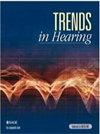(为什么)透明听力设备会影响同处噪音中的语音感知?
IF 3
2区 医学
Q1 AUDIOLOGY & SPEECH-LANGUAGE PATHOLOGY
引用次数: 0
摘要
助听器和其他听力设备应为用户带来好处,例如补偿听力损失或消除不想要的声音。然而,佩戴助听器也会对感知能力产生负面影响,这主要是在空间听力、音质和对自己声音的感知方面。如果将助听器设置为透明状态,即不提供增益,并尽可能类似于开耳式聆听,则可以单独研究这些副作用。在本研究中,我们进行了一系列实验,研究透明听力设备对噪声中语音任务中语音感知的影响。在这种情况下,通过助听器聆听预计不会产生任何负面影响,因为语音和噪声都经过了相同的处理,因此耳朵的信噪比不会改变,空间效应也无关紧要。然而,我们发现听力设备对语音清晰度的不利影响是一致的,而对听力努力程度的影响也有类似的趋势。通过使用几种不同的设备、增益设置和刺激水平,我们对造成这种劣势的可能原因进行了几种假设检验。虽然排除了自噪声和非线性失真的影响,但听力设备对言语感知不利的确切原因仍不清楚。然而,与听觉模型预测的显著关系表明,语音清晰度的劣势与音质有关,很可能是由于均衡不足、频率相关信号处理的伪影和处理延迟造成的。本文章由计算机程序翻译,如有差异,请以英文原文为准。
(Why) Do Transparent Hearing Devices Impair Speech Perception in Collocated Noise?
Hearing aids and other hearing devices should provide the user with a benefit, for example, compensate for effects of a hearing loss or cancel undesired sounds. However, wearing hearing devices can also have negative effects on perception, previously demonstrated mostly for spatial hearing, sound quality and the perception of the own voice. When hearing devices are set to transparency, that is, provide no gain and resemble open-ear listening as well as possible, these side effects can be studied in isolation. In the present work, we conducted a series of experiments that are concerned with the effect of transparent hearing devices on speech perception in a collocated speech-in-noise task. In such a situation, listening through a hearing device is not expected to have any negative effect, since both speech and noise undergo identical processing, such that the signal-to-noise ratio at ear is not altered and spatial effects are irrelevant. However, we found a consistent hearing device disadvantage for speech intelligibility and similar trends for rated listening effort. Several hypotheses for the possible origin for this disadvantage were tested by including several different devices, gain settings and stimulus levels. While effects of self-noise and nonlinear distortions were ruled out, the exact reason for a hearing device disadvantage on speech perception is still unclear. However, a significant relation to auditory model predictions demonstrate that the speech intelligibility disadvantage is related to sound quality, and is most probably caused by insufficient equalization, artifacts of frequency-dependent signal processing and processing delays.
求助全文
通过发布文献求助,成功后即可免费获取论文全文。
去求助
来源期刊

Trends in Hearing
AUDIOLOGY & SPEECH-LANGUAGE PATHOLOGYOTORH-OTORHINOLARYNGOLOGY
CiteScore
4.50
自引率
11.10%
发文量
44
审稿时长
12 weeks
期刊介绍:
Trends in Hearing is an open access journal completely dedicated to publishing original research and reviews focusing on human hearing, hearing loss, hearing aids, auditory implants, and aural rehabilitation. Under its former name, Trends in Amplification, the journal established itself as a forum for concise explorations of all areas of translational hearing research by leaders in the field. Trends in Hearing has now expanded its focus to include original research articles, with the goal of becoming the premier venue for research related to human hearing and hearing loss.
 求助内容:
求助内容: 应助结果提醒方式:
应助结果提醒方式:


